Experts Reveal: Recommended Screen Time by Age | 2024 Update
It seems like every expert has their own screen time recommendation, so how can you really know what is best for your child? As a parent, you need to give your kids the freedom to be online, use their apps, and communicate with friends. However, it’s crucial to ensure a healthy balance between their online and offline lives to prevent screen time addiction and common health and behavioral issues associated with excessive screen time.
There are specific limitations based on the child’s age, which I’ll go through in detail below, but knowing the proper screen time limits is only the first step. Kids, who believe they know what’s best, will try and find a way to get more screen time than the recommended limits (studies show that the average teen spends more than three hours above the recommended limit). Therefore, you also need to have the right tools and rules for enforcing these limits. After months of research, I found that the best and easiest method is by installing a premium screen time limit tool that will ensure my child won’t be able to exceed the allowed screen time.
After testing over 30 screen time limit tools, I found that Qustodio stood out as the best app for limiting screen time. It has a daily screen time limit, a schedule of what times the phone can’t be used, time limits for individual apps, and it can lock the phone at any time. Best of all, you don’t have to take my word for it, when you can try Qustodio free for 30 days, no credit card required, and see for yourself how easy it is to enforce screen time limits on all your child’s devices – computer, phone, and tablet.
Try Qustodio Free for 30 Days!
Quick Guide: What are the Recommended Screen Time Limits for My Child?
According to several leading pediatric associations and child health professionals, screen time guidelines are as follows:
- Ages 6 – 17: Two hours of recreational screen time a day is ideal.
- Ages 2 – 5: Up to an hour of non-educational screen time is acceptable.
- Ages 18 months – 2 years old: Less than an hour of screen time, for educational use.
- Ages 0-18 months: No screen time, except for video chatting with family members.
See the 4 recommended ways to limit your child’s screen time
Try Qustodio Free for 30 Days!
Recommended Screen Time by Age | 2024 Update
Experts recommend setting screen time limits for children and teenagers to promote healthy development and prevent the negative effects of excessive screen time. These limits may vary depending on factors such as age, type of screen activity, and individual needs. Research suggests that excessive screen time can lead to sleep problems, obesity, and other health issues, highlighting the importance of establishing appropriate screen time guidelines.
Recommended Screen Time Limits and Guidelines for Kids 6 – 17 Years Old
This is a very diverse group in terms of development and access to screens, movies, games, and more. However, from a developmental and mental health perspective, they are not that different. It is recommended that screen time be limited up to two hours per day of non-educational use.
Encouraging physical activity over screen time usage and developing different habits can teach them the value of creating a healthy balance. This is also a good age to instill new behaviors that will prevent screen time addiction as they grow up, such as not having a phone in bed, turning off screens during dinner, and muting chats and other notifications while doing schoolwork.
To help you and avoid daily fights over devices, it is recommended to use a parental control app. This can establish a known routine where the allowed time is set in advance and cannot be bypassed. After a few months of use, new and healthy habits will become the norm. Among all parental control apps, Qustodio has the most generous offer, and they provide full access to all features free for 30 days with no credit card required. You can download it now to help build better screen habits for your child.
Recommended Screen Time Limits and Guidelines for Kids 2 – 5 Years Old
Officially, the screen time limit should be an hour a day, but you can make an exception on the weekend and extend it to three hours. It’s best that the screen time is done on a larger screen, such as a tablet, computer or television, as this causes less strain on the eyes.
The best kind of screen time for this age group is interactive programming, as it prevents them from just watching. Based on my testing, Qustodio is the best app for this age group, because it can block or set screen time limits on individual apps. My almost 4-year-old knows how to open YouTube on my phone, and can start Paw Patrol or other videos that he likes by himself. By using Qustodio, I can block YouTube or any app, and prevent my child from mindlessly watching videos. Qustodio has a completely free 30-day free trial, so you can install it on your phone, computer, and tablet, and start creating healthy screen time habits for your child at a young age.
Recommended Screen Time Limits and Guidelines for Kids 18 – 24 months
As your child grows from a baby to a toddler, it’s important to continue setting limits on their screen time. Don’t let them spend more than an hour in front of the screen, and it’s best to avoid providing them with access to phones or tablets for independent use.
Ideally, screen time for toddlers should be restricted to educational content watched alongside a parent or caregiver. Avoid giving in to the temptation of handing your phone to your child if they become restless, as this may inhibit their ability to engage with their surroundings and the people around them.
Recommended Screen Time Limits and Guidelines for Kids Up to 18 Months
Babies up to 18 months are still developing their brain functions and visual stimulations, and any screen time can have a negative effect. According to the American Association of Pediatrics, the one exception is video chatting with family, as long as it’s a quick call and doesn’t happen daily.
Too much screen time can add extra stress to the baby’s visual system, and sensory overload can damage their development.
Note: The only proven method for enforcing screen time limits, even when you’re not with your child, is a premium parental control app. Qustodio excelled in all my tests, both in terms of creating custom rules and preventing my kids from adjusting the rules disabling the app, or uninstalling it from the computer or phone. You don’t have to take my word for it, try Qustodio free for days, with no credit card required, and see how easy it is to limit your child’s screen time.
Try Qustodio Free for 30 Days!
Revealed: Too Much Screen Time Can Lead to Serious Danger
The effects of excessive screen time on children’s development are a growing concern. It is common to observe children spending long hours staring at their screens, leading to a lack of attention and irritable behavior when the screen time ends. Research has linked excessive screen time to various developmental problems in children. These problems include, but are not limited to, delays in cognitive development, language skills, and social skills. Additionally, excessive screen time has been linked to physical health issues such as back pain, obesity, and eye strain. It is crucial to address this issue and establish healthy screen time habits to prevent these problems from arising.
⚠️ Delayed Speech and Language Skills
Young children learn language through social interactions and conversations with parents, caregivers, and peers. However, excessive screen time may reduce these opportunities for language interactions, leading to delays in speech and language skills. For example, if a child is spending more time watching videos on a device than engaging in conversations, they may not be learning important language skills like turn-taking, listening, and responding.
⚠️ Poor Social Skills
Too much screen time can also affect children’s social skills by reducing opportunities for face-to-face interactions. Children who spend more time on screens may struggle with communication, problem-solving, and making friends. For example, they may struggle to read social cues, like facial expressions and body language, or may have difficulty initiating and maintaining conversations.
⚠️ Difficulty at School
Studies have shown that excessive screen time is negatively correlated with academic performance. Children who spend more time on screens can experience reduced attention span, lower grades, and decreased memory. Additionally, too much screen time can lead to a lack of focus and increased distractibility, making it harder for kids to concentrate on their academic tasks.
⚠️ Lack of Physical Activity
Excessive screen time can contribute to a sedentary lifestyle, reducing opportunities for physical activity. This can lead to health problems such as obesity, diabetes, and cardiovascular disease. Moreover, a lack of physical activity can negatively impact children’s cognitive development and academic performance.
⚠️ Sleep Disturbances
The blue light emitted by screens can disrupt the body’s natural sleep cycle, leading to sleep disturbances and related issues like irritability, difficulty concentrating, and decreased academic performance. Additionally, lack of sleep can affect children’s emotional well-being, causing mood swings and behavioral problems.
Too much screen time can lead to various developmental issues in children. This is why it is essential to be in control and make sure that children are not too attached to screens, as excessive screen time can have a negative impact on their overall development. To limit screen time, parents can use parental control apps, such as Qustodio, which allows parents to set daily screen time limits, block specific apps, and create a screen time schedule.
Try Qustodio Free for 30 Days!
4 Ways to Limit Your Child’s Screen Time in 2024
Today’s children spend, on average, between 5-7 hours a day looking at televisions, computers, phones, and other electronic devices. This is well above the recommended limits set by child psychologists, pediatricians, and mental health experts.
To avoid constant arguments with my children about their screen time, I searched for effective solutions that balanced their desire to stay connected while also protecting them from the dangers of excessive screen time exposure. Below are four tried-and-true methods that I use with my own children, which I believe could benefit your family as well.
✅ Use a Parental Control App to Set Screen Time Limits
Parental control apps give parents the final say in when and for how long, their child can be on their screens. The top apps combine a daily screen time limit, a usage schedule, and screen limits for specific apps.These features allow parents to set clear boundaries and help teach their kids about healthy habits.
There are several reasons that a parental control app is the best solution for limiting screen time. First of all, they give parents the ultimate control without having to stand over the child and make sure they step away from the phone, computer or tablet. The parental control app works remotely, you can change the screen time limits or even block the phone from anywhere. Another major benefit is cross-platform compatibility. Set screen time limits that combine all the child’s screen time on phones, computers, and tablets. I’ve tested over 30 parental control apps and found 3 that do a great job at setting and enforcing screen time limits.
Qustodio: Comprehensive Screen Time Controls, Including Time Limits for Individual Apps
When it comes to monitoring and limiting my son’s screen time, Qustodio stood out as the best solution. It was a literal life changer in my house, as it removed the possibility of my son using more screen time than I allowed. Whether I’m at home, at work, or out for the evening, when my son reaches the screen time limits I set in Qustodio, all he sees is a lock screen from Qustodio telling him his screen time is up. Unlike screen time tools that come built into some phones or browsers, Qustodio is extremely difficult for kids to disable or bypass the rules.
It took a few days for my son to adjust, but he quickly understood that I set an overall daily screen time and a screen time schedule. This meant that he had to learn to budget his screen time throughout the day. If he used all his allotted time by early afternoon, then there would be no screen time in the evening.
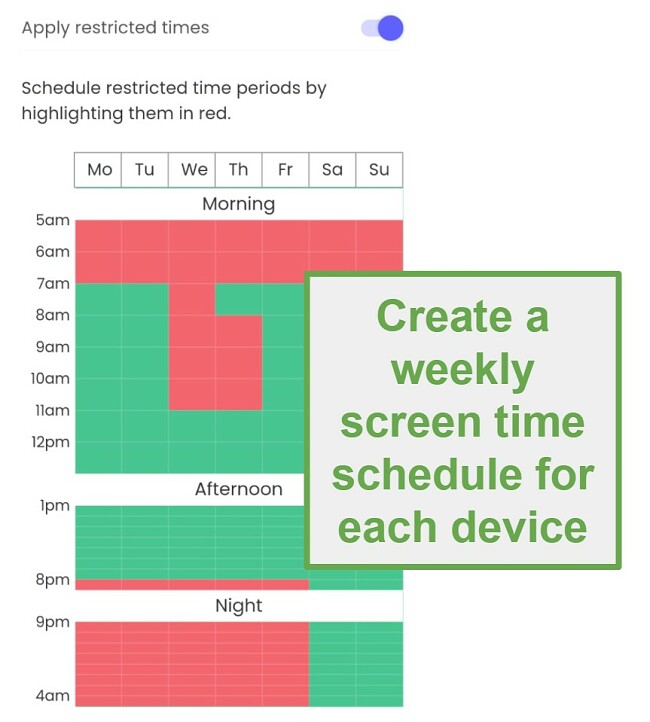
Additionally, Qustodio has the option to set screen time limits or block individual apps. This is especially important with apps that are addictive or if you know that your child spends too much time on them. Qustodio is compatible with mobile devices and computers, and you can manage them all from one dashboard.
Qustodio is more than just a screen time tool. It also has a comprehensive web filter with 29 categories, 24/7 live location tracking, and SOS or panic button, and remote app management tools.You can try Qustodio free for 30 days, with no credit card required, and see how much easier it will be to set comprehensive screen time limits.
Try Qustodio Free for 30 Days!
Bark: Create Daily Screen Time Routines to Create Healthy Habits
The Bark app is designed to help kids establish healthy screen time habits. Instead of setting a daily screen time limit, it has a screen time routine. There are four distinct time segments – School, Free Time, Bedtime, and Default – that can be assigned to different parts of the day. Each segment is fully customizable, and you can choose which apps are available during each one. For example, you can block all non-educational apps during school time and use Free Time for two hours a day to unlock all entertainment and social media apps.
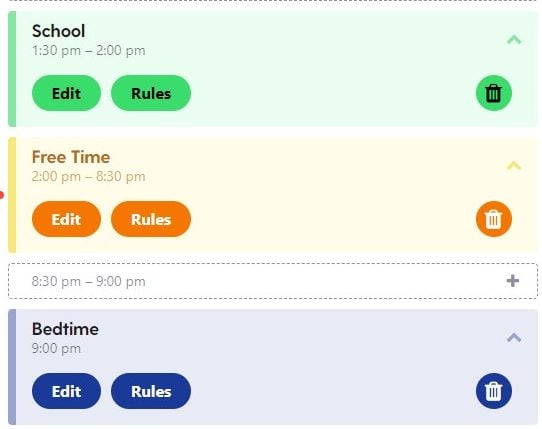
Bark also offers a Pause Device button on the parental dashboard, allowing you to block the device’s internet connection. It is compatible with Android, iOS, and Amazon Fire and has no device limits, so you can set screen time limits for all your family’s devices.
I also use Bark as a valuable tool for monitoring my son’s online interactions. It uses an AI filter to monitor over 30 social media apps, email platforms, and browsers. If a comment, post, picture, or video triggers its filter, it uploads the offending content to my dashboard so I can review it in the proper context. If you want to test it yourself, you can Try it free for 7 days, and get unlimited access to all its premium features.
Norton Family: Set Daily Screen Limit and Usage Schedule
Norton Family is a straightforward parental control app that offers both a daily screen time limit and the option to create a screen time schedule. The only downside of this tool is that it is not very flexible. Both features rely on setting limits in 30-minute time blocks, which does not reflect the actual schedule at home or school.
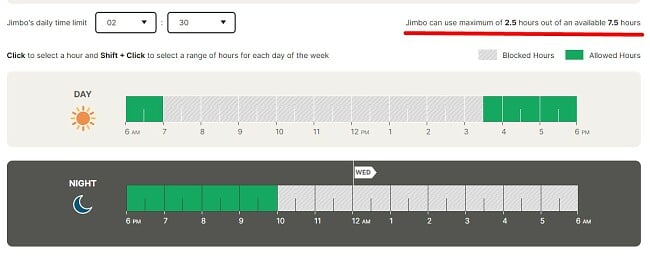
Norton Family also has a school time or remote learning feature that will block all non-educational websites when activated. While there is no free trial available, Norton Family has a proven 30-day money-back guarantee, which will give you enough time to test the screen time tools on your children.
Try Norton Family Risk Free for 30 Days!
✅ Create Tech-Free Zones
It’s important to establish tech-free zones in your home, such as the dinner table or your child’s bedroom. This helps reduce the amount of time your child spends in front of screens and encourages family interaction. Tech-free zones can also help promote a sense of calm and relaxation, particularly in areas where your child is supposed to be resting or sleeping.
When creating tech-free zones, involve your child in the process. Explain why these areas are important and work together to establish rules and boundaries around their use. This can help your child feel empowered and invested in the process and increase their motivation to follow the rules.
However, this method will only work if you are at home and constantly telling your child to leave their phone or tablet out of the tech-free zone. A more reliable option is a parental control app, especially one that comes with the ability to instantly pause the device so you can lock the phone, even if the child still has screen time remaining. Based on my tests, the Qustodio app is the best option, since you can set specific times, such as dinner time, when the device isn’t available. You can try Qustodio free for 30 days, with no credit card required to activate the free trial, and see how much easier it is to enforce screen time habits.
✅ Use the Pomodoro Technique
The Pomodoro Technique is not specifically a screen time limiting technique; rather, it is a time management method that can be applied to various tasks, including screen time activities. The technique involves breaking work into short, focused intervals (usually 25 minutes) called “Pomodoros,” followed by a short break. After completing four Pomodoros, a longer break is taken.
When applied to screen time, the Pomodoro Technique can help limit and manage the time spent on devices. By setting a Pomodoro for an activity like browsing social media or playing games, kids become more aware of the time spent on screens and can balance it with regular breaks. These breaks help reduce eye strain, improve focus, and encourage healthier habits by incorporating physical activity or social interactions during the breaks. Overall, the Pomodoro Technique can be an effective way to manage and limit screen time while fostering productivity and well-being.
✅ Be a Good Role Model Model and Create Healthy Habits
As a parent, it’s important to be a good role model by practicing healthy screen time habits yourself. This includes setting boundaries for your own screen time and demonstrating the importance of other activities such as exercise, socializing, and reading. When you prioritize these activities in your own life, you send a message to your child about their importance.
In addition to modeling healthy habits, it’s crucial to engage in open and ongoing conversations with your child about your own screen time practices. Explain the rationale behind setting personal boundaries and balancing screen time with other activities. This can help your child gain a better understanding of healthy screen time habits and encourage them to adopt similar practices. However, screen time addiction is so powerful that even with a role model, the urge to check screens can be challenging to resist without an app to enforce screen time limits.
Qustodio is an effective tool that enforces your screen time rules and prevents your child from spending excessive time on screens. Once you establish daily screen time limits and a usage schedule, you can rest assured that their screen time will be reduced to a healthy level. If you’re uncertain whether it’s the right solution for you, try Qustodio free for 30 days, with no credit card required. You’ll discover how easy it is to set up and manage, and see the desired change immediately.
Try Qustodio Free for 30 Days!
FAQ
What is the recommended screen time limit for kids and teens?
What is the best method for limiting screen time?
What is the danger of too much screen time?
A Premium Parental Control App is the Best Tool For Limiting Screen Time
While there are many different methods for limiting screen time, most of them have one major flaw: the child has to agree in some way to putting down the phone or walk away from the computer.
The best solution is a premium parental control app because it takes away that option from the child, and they have no choice but to follow the rules. As a parent, you only have to set it once, and it will enforce your rules until you make a change. The best parental control app I’ve tested for limiting screen time is Qustodio. It has comprehensive and flexible screen time rules for phones, tablets, and computers. It allows you to set a daily screen time limit, a device usage schedule, set time limits for individual apps, and it has an Instant Lock feature so you can block the device at any time. You can try Qustodio free for 30 days, no credit card required, and see for yourself how easy it is to ensure your kids don’t spend too much time looking at screens.

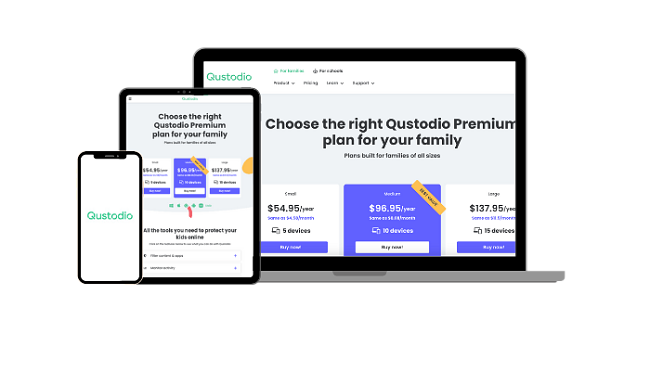
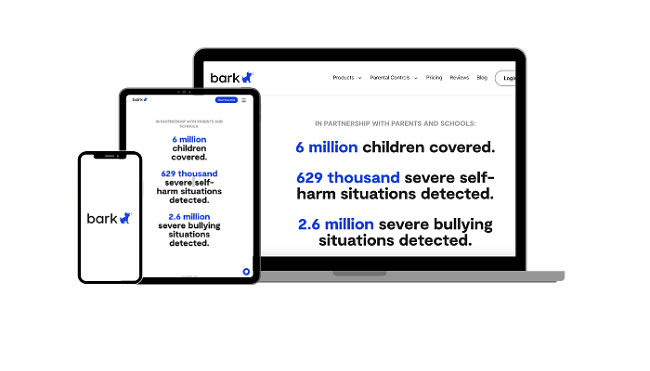





Leave a Comment
Cancel